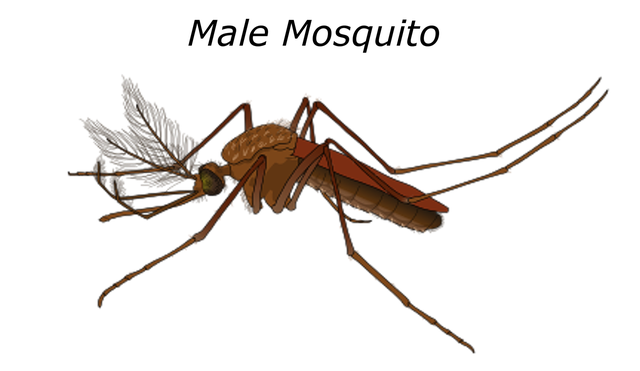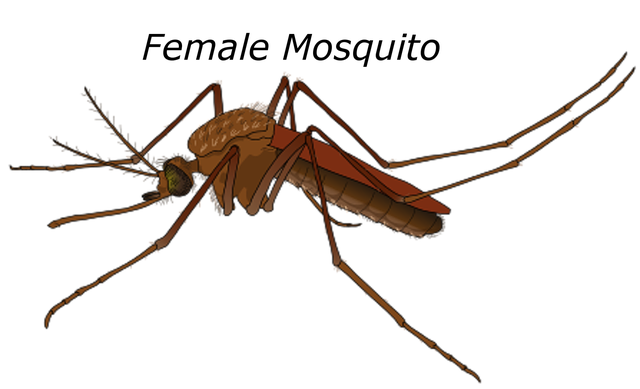Difference Between Male and Female Mosquito
“Mosquito” came from the Latin word “musca” which means fly and the Spanish suffix “-ito” for “little”; hence, “little fly”. Its scientific name is “culicidae” with an average lifespan of two weeks to six months. Like similar insects, the mosquito’s life cycle includes stages which are the egg, larval, pupal, and adult. A cycle is completed from four to 14 days.
With the naked, male and female mosquitoes generally look similar. However, male mosquitoes are usually smaller as compared to their female counterparts. Moreover, the female mosquitoes are the only ones who suck blood. The following discussions further delve into their distinctions.

What is a Male Mosquito?
A male mosquito’s lifespan lasts for about seven days. However, some male mosquitoes only survive after a day or even less. Like butterflies, they feed on nectar and other sweet juices. Regarding physical appearance, their proboscises appear bushy and feather-like. Also, the hairs on their antennae help them detect sounds. These hairs are crucial during mating as they assist in finding female mosquitoes’ tiny buzzing sounds.
What is a Female Mosquito?
A female mosquito’s typical lifespan is seven to 14 days but some can live up to 30 days. Female mosquitoes are designed to live longer since they still have to carry their eggs and deposit them in suitable locations. The blood meals that they take can also nourish them for longer periods of time. As for their appearance, they are distinguished by their smoother proboscises and non-feather-like antennae. Unlike their male counterparts, they need to suck blood to have enough protein needed in producing eggs. This is why they only need to drink blood after mating. Without the bloods’ nutrition, they lose their ability to reproduce.
The following table shows the common types of mosquitoes, the diseases that they primarily transmit, and their usual habitats:
| Type | Disease/Virus | Habitat |
| Anopheles | Malaria | Swamps, ponds, rain pools |
| Aedes aegypti | Dengue fever, chikungunya, Zika fever, Yellow fever, Mayaro fever | Containers with stagnant water, floodwater pools, marshes |
| Culex | St. Louis Encephalitis and West Nile Virus | Ponds, ditches, freshwater pools |
| Coquillettidia | Eastern Equine Encephalitis | aquatic plants |

Difference between Male and Female Mosquito
-
Lifespan of Male Vs. Female Mosquito
Females have a longer lifespan as they typically live for 1 to 2 weeks while males only live for about a week.
-
Proboscis
The proboscises of male mosquitoes are bushy and the wisps are highly visible under a microscope while those of female mosquitoes are smoother and needle-like for cutting into skin and sucking blood. The females’ saliva combined with the tiny cut causes the itchy reddish bump.
-
Antennae
Unlike those of female mosquitoes, the antennae of male mosquitoes have hair for echolocating the females as their main purpose is to deposit sperm.
-
Size
Generally, male mosquitoes are smaller than female mosquitoes since a bigger body frame is needed for carrying eggs.
-
Food
Female mosquitoes need to suck blood for reproduction while male mosquitoes get nourishment from nectars and other similar juices. The females are only capable of biting mammals after two days of being adults. Their initial food is nectar and fruit juices like the males.
-
Hatching
Male mosquitoes tend to hatch earlier than their female counterparts. This may be due to the fact that adult males linger near breeding sites, waiting for females.
-
Diseases
Since the female mosquitoes are the only ones sucking blood, they can be carriers of diseases such as malaria, dengue fever, and encephalitis. On the other hand, male mosquitoes are relatively harmless.
-
Buzz
As compared to male mosquitoes, the buzz of female mosquitoes is at a higher pitch as their wings beat as much as 500 times per second. The males utilize this distinct sound when looking for a mate.
-
Proximity to Humans
Male mosquitoes typically stay away from humans as they do not take blood meals. On the contrary, female mosquitoes get nourished by the blood of humans which has the protein needed in carrying and laying eggs. They are attracted to mammals’ body heat and carbon dioxide.
-
Role of Male Vs. Female Mosquito
The one and only purpose of male mosquitoes in their world is the production of sperm. As for females, their roles after mating are to store the sperm and to develop, carry, fertilize, and lay eggs. This makes the role of the female mosquitoes more complicated and important for the survival of their species.
-
Frequency of Mating
Male mosquitoes can mate more than once as their role is to deposit their sperm in as many female mosquitoes as possible. On the other hand, the females only mate once in their life.
-
Reaction to Repellents
According to an experiment, female mosquitoes are more sensitive to insect repellents as they significantly took off more than the male mosquitoes. This is congruent with the fact that female mosquitoes need to survive to protect their eggs.
Male vs Female Mosquito: Comparison Table

Summary of Male Mosquito Vs. Female Mosquito
- Female mosquitoes live longer than their male counterparts.
- As compared to female mosquitoes, male mosquitoes tend to be smaller, have bushy proboscises, and hatch earlier.
- The female mosquitoes suck blood; hence, they can carry diseases but the males do not.
- Male mosquitoes can mate many times as their purpose is to deposit sperm while the females can only mate once since their role is to carry and lay eggs.
- Difference Between Hematoma and Melanoma - February 9, 2023
- Difference Between Bruising and Necrosis - February 8, 2023
- Difference Between Brain Hematoma and Brain Hemorrhage - February 8, 2023
Search DifferenceBetween.net :
Leave a Response
References :
[0]Image credit: https://pixabay.com/en/male-mosquito-malaria-bug-pest-1007783/
[1]Image credit: https://pixabay.com/en/female-mosquito-malaria-bug-pest-1007784/
[2]Anderson, Scott, Dierckins, Tony, and Pearson, Scott. The Mosquito Book. NY: X Communications, 2004. Print.
[3]Barnard, Donald. “Biological Assay Methods for Mosquito Repellents.” Journal of the American Mosquito Control Association 21.4 (2005):12-16. Print.
[4]Spielman, Andrew and D’ Antonio, Michael. Mosquito: The Story of Man’s Deadliest Foe. NY: Hyperion, 2001. Print.
